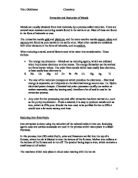- Any other further processing required after extraction has been carried out, such as the purity requirement – From a mineral, it is easy to produce metals such as iron, which is 95% pure. Should the iron need to be purified further to 99% it would cost a lot more money, and time.
Reducing Iron from Fe2O3
Iron extraction is done using the reduction of the mineral oxide in iron ore. Reducing agents coke and carbon monoxide are used in the process which takes place in a Blast Furnace.
In this process, iron (III) oxide Fe2O3, coke and limestone are fed into the top of a furnace, where hot air is blasted in near the bottom of the furnace. Molten iron collects at the bottom of the furnace and is run off. The product being impure iron, which contains a small amount of carbon
The reactions which take place in clued coke reacting with the hot air.
C + O2 2CO2
The unreacted coke then reacts with the carbon dioxide formed from the high temperature, to form carbon monoxide.
CO2 + C 2CO
The carbon monoxide reduces the iron (III) oxide at around 1200oc.
Fe2O3 + 3CO 2Fe + 3CO2
In the hottest part of the furnace (lower down) the remaining coke reacts directly with iron oxide.
Fe2O3 + 3C 2Fe + 3CO
The other product form is slag, which contains impurities from the ore combined with lime, and is mostly calcium silicate.
The main limitations of using this method is that iron can only be extracted from its ores at very high temperatures, using a large amount of energy, costing a lot of money. To solve this problem, the production is operated continuously, 24 hours a day for several years without break, this minimises costs. The other main danger is that the use of raw materials, and should the production fail or input stop, the delay and restart could cost millions of pounds. There is also a possibility of running out of the raw materials.
Extraction of Aluminium from Bauxite
This process is called Electrolysis. The mineral bauxite is used as the source of the oxide. This oxide is ground, and reacted with sodium hydroxide, giving aluminium hydroxide which is heated to produce a pure oxide. The electrolysis of aluminium oxide is carried out in an iron bath (a cell) which is lined with graphite which acts as the cathode.
Aluminium oxide has a boiling point of about 2050oc. Therefore the oxide is mixed with Cryolite which reduces the cost of keeping the oxide at molten form.
The ions Al3+ and Na+ become attracted to the cathode, and the ions O2- and AlF63- are attracted to the anode. The anode is a series of carbon blocks which are replaced regularly due to the extreme temperatures. Molten aluminium collects at the bottom of the cell and is separated and collected at intervals, a cell can produce about 1300kg of aluminium per day.
The major expense of this method is the cost of electric power needed. As well as being needed to break down the aluminium oxide, current is also used to maintain the temperature of the cell.
Extraction of Titanium metal
This is done using a process called the Kroll Process. It starts by converting Titanium (IV) oxide with chloride TiCl4, by heating it with carbon in chlorine gas.
TiO2 + 2Cl2 + 2C TiCl4 + 2CO
Titanium chloride can be purified using fractional distillation.
Titanium is then extracted from the chloride using the Kroll Process. Titanium (IV) chloride and liquefied magnesium are heated in an unreactive inert atmosphere of helium or argon gas. The reduction reaction is a displacement.
TiCl4 + 2Mg Ti + 2MgCl2
The method only has a limited use because the procedure is a batch process, the furnace does not operate continuously, but it is cooled after each operation so that the titanium can be removed.
Titanium metal is very strong. It also has a very low density, and does not corrode even under the most extreme conditions. It also has an excellent strength at high temperatures. Because of these properties, it is widely used for the requirements of jet turbines, which work at extreme temperatures and pressure, over a long period of time.







